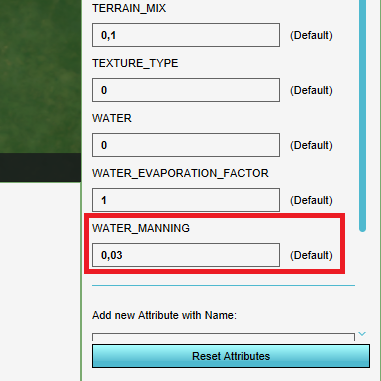Terrain water manning (Water Overlay): Difference between revisions
Jump to navigation
Jump to search
(→Notes) |
(→Notes) |
||
| Line 14: | Line 14: | ||
* If a construction is present on the terrain, the [[Water manning (Water Overlay)|WATER_MANNING]] value of the construction is used instead. | * If a construction is present on the terrain, the [[Water manning (Water Overlay)|WATER_MANNING]] value of the construction is used instead. | ||
* Only terrains of type '[[Terrain#Surface|surface]]' have an assigned WATER_MANNING. | * Only terrains of type '[[Terrain#Surface|surface]]' have an assigned WATER_MANNING. | ||
[[File:Water_manning.png|200px|thumb|none|alt=Alt text|The default value for the WATER_MANNING attribute of surface type "Open land". The user can change this value.]] | [[File:Water_manning.png|200px|thumb|right|none|alt=Alt text|The default value for the WATER_MANNING attribute of surface type "Open land". The user can change this value.]] | ||
====See also==== | ====See also==== | ||
Revision as of 16:16, 15 October 2019
Manning's n (terrain)
Terrains have an inherent "roughness", affecting the flow of water across their surface, which is expressed by the Gauckler–Manning coefficient or, in short, Manning's value (n).
Notes
- The default values for this attribute are derived from online accessible databases[1] and are readily adjusted by the user.
- If a construction is present on the terrain, the WATER_MANNING value of the construction is used instead.
- Only terrains of type 'surface' have an assigned WATER_MANNING.
See also
References
- ↑ WikiEngineer (2008-2011). Manning Roughness Coefficients. Retrieved from: http://wikiengineer.com/Water-Resources/ManningRoughnessCoefficients





